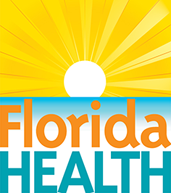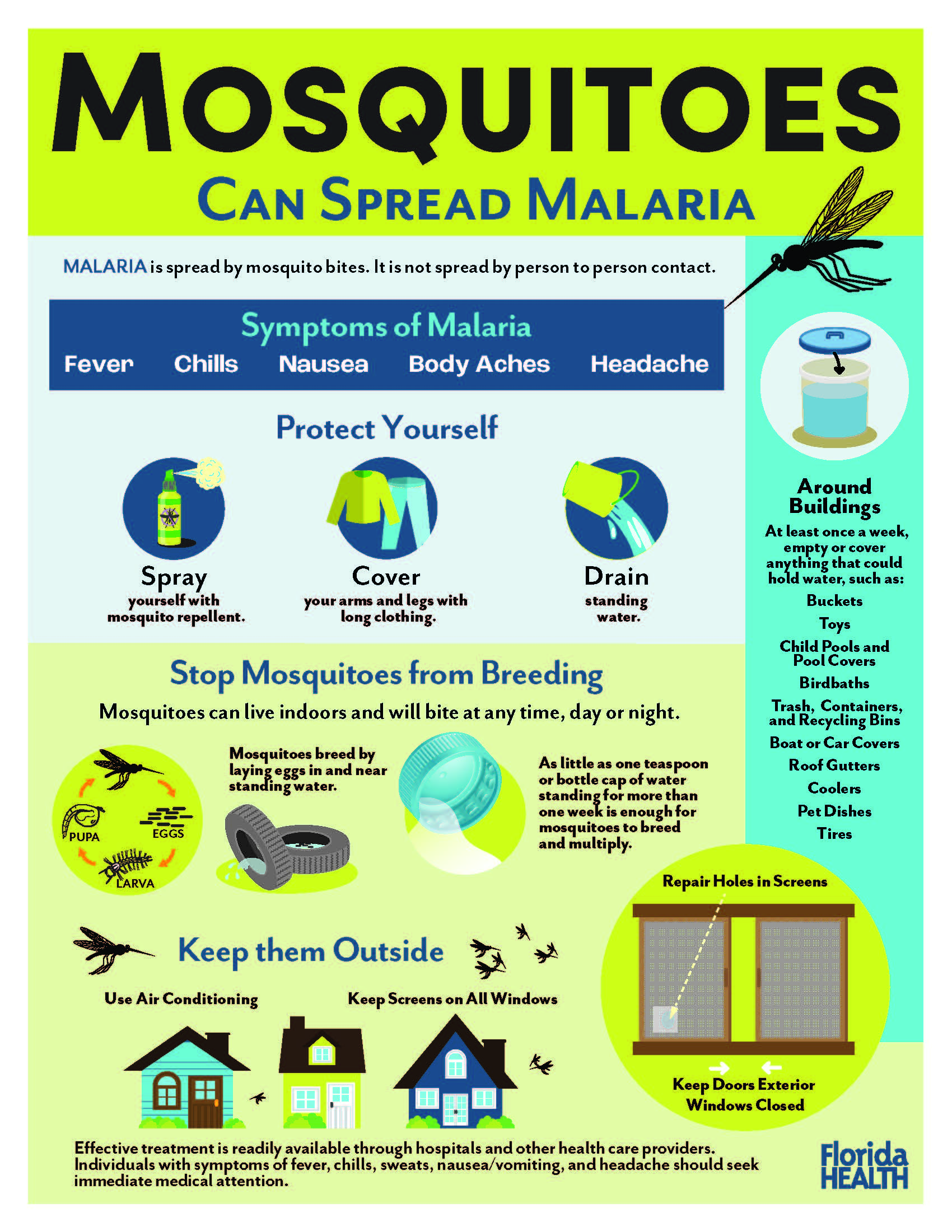It's a New Day in Public Health.
The Florida Department of Health works to protect, promote, and improve the health of all people in Florida through integrated state, county, and community efforts.
Malaria
Florida Department of Health has Issued an Advisory Regarding Mosquito-Borne Illnesses
Read More
On June 26, 2023, the Florida Department of Health (Department) issued a statewide mosquito-borne illness advisory following the detection of local malaria in Sarasota County. To date, seven local cases of malaria have been treated and have recovered, and all cases have been isolated to Sarasota County. There are no additional suspected cases at this time.
Since the initial case was confirmed, the Department has worked diligently with local partners to keep communities informed and educated on mosquito-borne illness prevention. Aerial and ground mosquito spraying continue to be conducted in these areas to mitigate the risk of further transmission.
In Florida, Malaria is transmitted through infected Anopheles mosquitoes, not through person-to-person contact. The cause of malaria in these local cases has been identified as the Plasmodium vivax species. Individuals in this area with symptoms of fever, chills, sweating, nausea/vomiting, and headache should seek immediate medical attention. Effective treatment is readily available through hospitals and other health care providers.
Residents throughout the state should take precautions by appropriately applying bug spray, avoiding areas with high mosquito populations, and wearing long pants and shirts when possible - especially during sunrise and sunset when mosquitos are most active.
Malaria is one of the world's greatest public health problems. It infects approximately 219 million people each year (range 154 – 289 million), with an estimated 660,000 deaths, mostly children in Africa. It is caused by four species of protozoan parasites of the genus Plasmodium: P. falciparum, P. vivax, P. malariae, and P. ovale and is transmitted by Anopheles species mosquitoes.
Preventing Mosquito Bites
If possible, remain indoors in a screened or air-conditioned area during the peak biting period between dusk and dawn:
- If no screening or air conditioning is available, use pyrethroid-containing repellent in living and sleeping areas during evening and night-time hours and sleep under bed nets, preferably insecticide-treated.
- Wear long-sleeved shirts, long pants, and hats when outdoors.
- Use insect repellent when outdoors. Sprays that contain DEET (N,N-diethyl-meta-toluamide) offer good protection. Follow the directions on the product label.
- Higher concentrations of DEET may have a longer repellent effect, however concentrations over 50% provide no added protection.
- Timed-release DEET products may have a longer repellent effect than liquid products.
- DEET should not be used on children younger than two months. Assist children less than 10 years old with application of repellant. Avoid applying repellant to young children’s hands, or around their eyes and mouth.
- Protect infants by using a carrier draped with mosquito netting with an elastic edge for a tight fit.
- Symptoms and Transmission
- Prevention
- Treatment
- Malaria Occurrence in Florida
- Malaria Risk in Travelers Visiting Friends and Relatives
- Resources and References
Symptoms
Symptoms of malaria depend on the Plasmodium species, but in most cases develop between 7-30 days after the bite of an infected mosquito. P. vivax can develop up to a year after exposure and if not treated properly can cause additional attacks (relapses).
Commonly, people experience flu-like symptoms such as fever, chills, sweats, headache, nausea and vomiting, body aches, and general malaise. P. falciparum can cause severe and life-threatening disease.
Transmission
P. falciparum and P. vivax were previously present in Florida, but was eradicated from the state in the late 1940s. Local transmission has occurred only rarely in recent years, likely due to mosquito control measures, improved housing with screens, use of repellents, and drainage practices. A number of malaria cases are reported in immigrant and travelers to areas where malaria risk is high.
There are 14 Anopheles mosquito species in Florida, all of which are potentially capable of transmitting malaria. An. quadrimaculatus and An. crucians have been major malaria vectors in the past. Since introduction from endemic areas occurs regularly and competent vectors exist in the state, local transmission is possible.
Preventing Mosquito Bites
If possible, remain indoors in a screened or air-conditioned area during the peak biting period between dusk and dawn:
- If no screening or air conditioning is available, use Insect Repellents in living and sleeping areas during evening and night-time hours and sleep under bed nets, preferably insecticide-treated.
- Wear long-sleeved shirts, long pants, and hats when outdoors.
- Use insect repellennts when outdoors. Sprays that contain DEET (N,N-diethyl-meta-toluamide) offer good protection. Follow the directions on the product label.
- Higher concentrations of DEET may have a longer repellent effect, however concentrations over 50% provide no added protection.
- Timed-release DEET products may have a longer repellent effect than liquid products.
- DEET should not be used on children younger than two months. Assist children less than 10 years old with application of repellant. Avoid applying repellant to young children’s hands, or around their eyes and mouth.
- Protect infants by using a carrier draped with mosquito netting with an elastic edge for a tight fit.
Persons experiencing symptoms and who have been in an area with malaria are encouraged to see a doctor immediately.
In 2023, Florida has reported confirmed cases in Sarasota County. All individuals have been treated and have recovered. The Department maintains a close collaboration with local partners and county mosquito control in its ongoing efforts.
The largest outbreak in recent Florida history occurred in Palm Beach County in 2003 where there were eight cases.
In 2012, 65 cases of imported malaria were reported in Florida:
- 45 cases (69%) were diagnosed with P. falciparum.
- 16 cases (25%) with P. vivax.
- 2 cases (3%) with P. ovale.
- 2 cases with P. malariae (3%).
Travelers to high malaria risk countries should talk to their health care provider about malaria prophylaxis and should take personal mosquito control measures.
Those classified as visiting friends and relatives are primarily from malaria-endemic developing countries. Individuals returning to their home country may be at increased risk for malaria. This increased risk has been attributed to high risk behaviors such as longer visit times and staying in villages and remote rural areas without screened windows or air conditioning. Additionally, those visiting friends and family are more likely to neglect personal protective measures against mosquitoes, such as prophylactic drugs, insect repellents, and bed nets. This may be because they believe themselves to be immune to the disease after having lived in an endemic area in the past. However, any immunity they may have had is lost over time, leaving them vulnerable to serious infections when they return to their home country.
Antimalarial Drug Guidelines
- Visit a health care provider familiar with travel medicine 4-6 weeks before traveling to countries that are endemic for malaria to obtain helpful travel information, vaccinations for other diseases, and antimalarial drug prescriptions.
- Purchase antimalarial drugs before traveling overseas to make sure that they are effective. Drugs bought in other countries may not be protective.
- Take all drugs as prescribed before, during and after travel for complete protection. Partial use may result in infection.




Connect with DOH